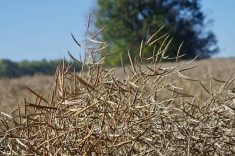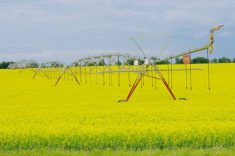For three-times-daily market reports from Resource News International, visit “ICE Futures Canada updates” at www.manitobacooperator.ca.
Mounting weather concerns across Western Canada finally made their way into the canola market during the week ended June 11, causing the futures to rally sharply higher on ideas that large areas will be left unseeded this year due to the excessive moisture plaguing the eastern Prairies. Technical buying added to the move higher as prices moved to levels not seen in months.
Read Also

Flea beetle control goes outside the box at Ag in Motion
The stops at the 2025 Ag in Motion farm show feature an entomologist experimenting with trap crops and marigolds as concepts to control flea beetles.
Most of the unseeded acres are in Saskatchewan, but Manitoba is dealing with moisture problems as well, with talk that many flooded-out areas will need to be reseeded. During the Canadian Wheat Board’s annual crop condition briefing held last week, the CWB estimated that anywhere from eight million to 12.5 million acres of farmland in Western Canada would be left unseeded this year. CWB weather analyst Bruce Burnett was noncommittal on how much of that total included canola, but agreed that the crop could account for a large portion of the lost acres.
Opinions are wide ranging and there is no clear consensus as to how many canola acres will actually be left unseeded. Of the crop that did get in the ground, much is still facing some fairly wet conditions, which could give rise to quality concerns down the road.
In any case, it seems to be a given that production will fail to meet early expectations, necessitating the climb higher in the futures over the past week. However, just how much more room there is to the upside remains to be seen.
The Canadian dollar also saw a sharp climb higher during the week, improving by about two cents compared to its U. S. counterpart. With canola seed and the Canadian dollar both stronger during the week, and soyoil relatively flat, crush margins dropped by about C$20 per tonne.
FOR LACK OF ALTERNATIVES
Western barley futures actually saw a few contracts trade hands during the week, nearly doubling the open interest from 12 contracts to 22. The burst of activity didn’t actually cause prices to see much movement and the barley market remains thin and range-bound overall. While the cuts to barley acres predicted by the CWB could be seen as supportive for prices, the poor planting conditions and generally wet weather could lead to more barley, wheat and other crops grading as feed. In addition, barley is one of those crops to which producers sometimes switch at the last minute as they run out of other alternatives.
In the U. S., the crop conditions aren’t nearly so worrisome and the generally favourable weather should be putting some downward pressure on corn, soybeans and wheat. However, short-covering helped all three markets post modest gains on the week. Demand could also be picking up, as recent weakness in the markets should be encouraging some buying interest.
Updated supply/demand tables from the U. S. Department of Agriculture were largely seen as market neutral, although projected corn stocks were on the tight side. The tighter corn stocks expectations were largely due to expectations for increased usage from the ethanol sector. Corn also benefited from ongoing demand from China, as the country was back in the market buying U. S. supplies during the week.
U. S. oats futures saw the largest increase in Chicago during the week, with much of that strength likely coming as a result of the Canadian weather concerns. Oats, like barley, are another crop that could see some extra acres go its way, but the quality will be questionable and yields will be reduced.
Looking beyond the commodities traded on the futures markets, the poor weather is also coming into play on other crops.
MAJOR REVISIONS
Lentils are one case in which the acres are very much up in the air. Statistics Canada’s initial lentil estimates were immediately discounted as being too small and market participants called for up to 3.5 million acres going to the crop. Some of that area will now likely end up unseeded, but there may still be more lentils in the ground than there were a year ago.
Peas, flaxseed, sunflower seed, corn, canaryseed, beans, mustard – all of these crops will likely see reduced area as well, with excess moisture causing problems for seeded fields. Yield estimates on all crops will likely see some major revisions as the growing season progresses and forecasters try to make sense of the unprecedented wetness.
For all the doom and gloom, there are those areas where the fields are still in fairly decent shape, aside from the low areas. I’ve talked with a few producers over the past week who’ve said, “You know, our fields have been sitting in water, but they seem to be pulling through just the same.”
Their fields not under water are also looking pretty good, although the weeds are coming up and they might need to do a little reseeding. There are probably a fair number of those producers who got most of their fields in before it turned wet; however, relatively decent fields don’t make the evening news and the problem areas remain a significant problem.
– Phil Franz-Warkentin and Dwayne Klassen write for Resource News International (RNI), a
Winnipeg company specializing in grain and commodity market reporting.


















